Fallen Flags: The Classic American Railroad
Last revised: October 26, 2024
By: Adam Burns
The term "Fallen Flags" describes those railroads whose corporate names have been dissolved through merger, bankruptcy, or liquidation. At one time the United States boasted nearly 140 Class I's.
- According to the Association of American Railroads, prior to 1956 this defined a carrier which earned at least $1 million in annual operating revenue. It has since been revised several times throughout the years. -
Today, many of these classic railroads are but a memory. The older folks reading this can remember those bygone days when corporations like the legendary Atchison, Topeka & Santa Fe Railway, the mighty Pennsylvania Railroad, and prosperous Southern Railway all served America.
And, of course, who can forget our country’s first common carrier, the Baltimore & Ohio Railroad, which survived for 160 years before disappearing into CSX Transportation in 1987.
There are many areas of the industry to study, ranging from locomotives to streamliners. However, few remain as popular, or as enjoyable, as the venerable "fallen flag." They defined the regions they served while providing invaluable transportation needs for local communities.
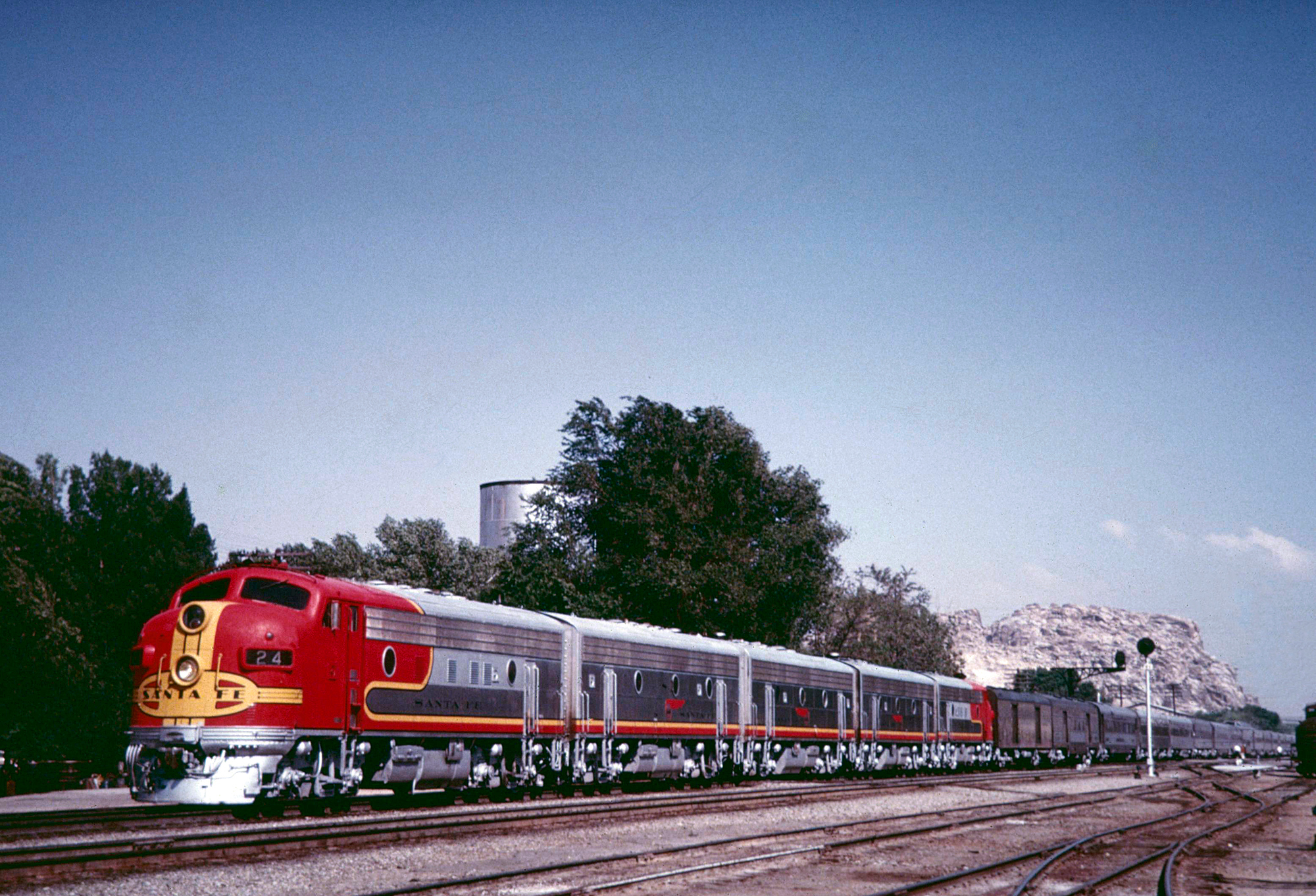 A handsome set of Santa Fe 'F' units, led by F3A #24-L, have train #20, the eastbound "Chief," at Victorville, California. Fred Worsfold photo. American-Rails.com collection.
A handsome set of Santa Fe 'F' units, led by F3A #24-L, have train #20, the eastbound "Chief," at Victorville, California. Fred Worsfold photo. American-Rails.com collection.History
Most of the fallen flags remembered today were derived from systems originally built during the 19th century. Some railroads, such as our country's first common-carrier, maintained their original name for well over a century while others were brought about through either consolidation or reorganization.
The railroad may have been born in England but it quickly caught on in the United States. Following the early chartering of the B&O, Mohawk & Hudson, South Carolina Canal & Railroad Company, and others by 1835 the fledgling country had 1,000 miles of track in operation according to the book "Railroads In The Days Of Steam," published by the editors of American Heritage.
In addition, as John Stover's title, "The Routledge Historical Atlas Of The American Railroads," points out expansion was rapid; of the twenty-six states in the Union by 1840 only four did not contain a single mile of track (Arkansas, Missouri, Tennessee, and Vermont).
Through 1860 there had already been more than $1 billion invested in the industry (interestingly, $200 million of this total came via English or European interests), which then boasted 31,246 miles in service.
At A Glance
1939 - 132 1963 - 102 1978 - 41 1988 - 12 1997 - 9 Present Day - 6 |
|
Until 1956 - $1 million 1956 - $3 million 1965 - $5 million 1978 - $50 million 1997 - $256 million 2019 - $505 million Present Day (2021) - $900 million |
|
98% Intercity Passenger Business 77% Intercity Freight Traffic |
|
Source: Stover, John. Routledge Historical Atlas of the American Railroads, The. New York: Routledge, 1999.
The growth only continued after the Civil War as promoters pushed ribbons of rail westward, highlighted by the completion of the Transcontinental Railroad in May of 1869. Construction quickened after this momentous event and peaked in the 1880's.
During that decade, as historian H. Roger Grant notes in his book, "The Corn Belt Route: A History Of The Chicago Great Western Railroad Company," the national network grew from 93,267 to 163,597 miles! It was the single greatest period of expansion.
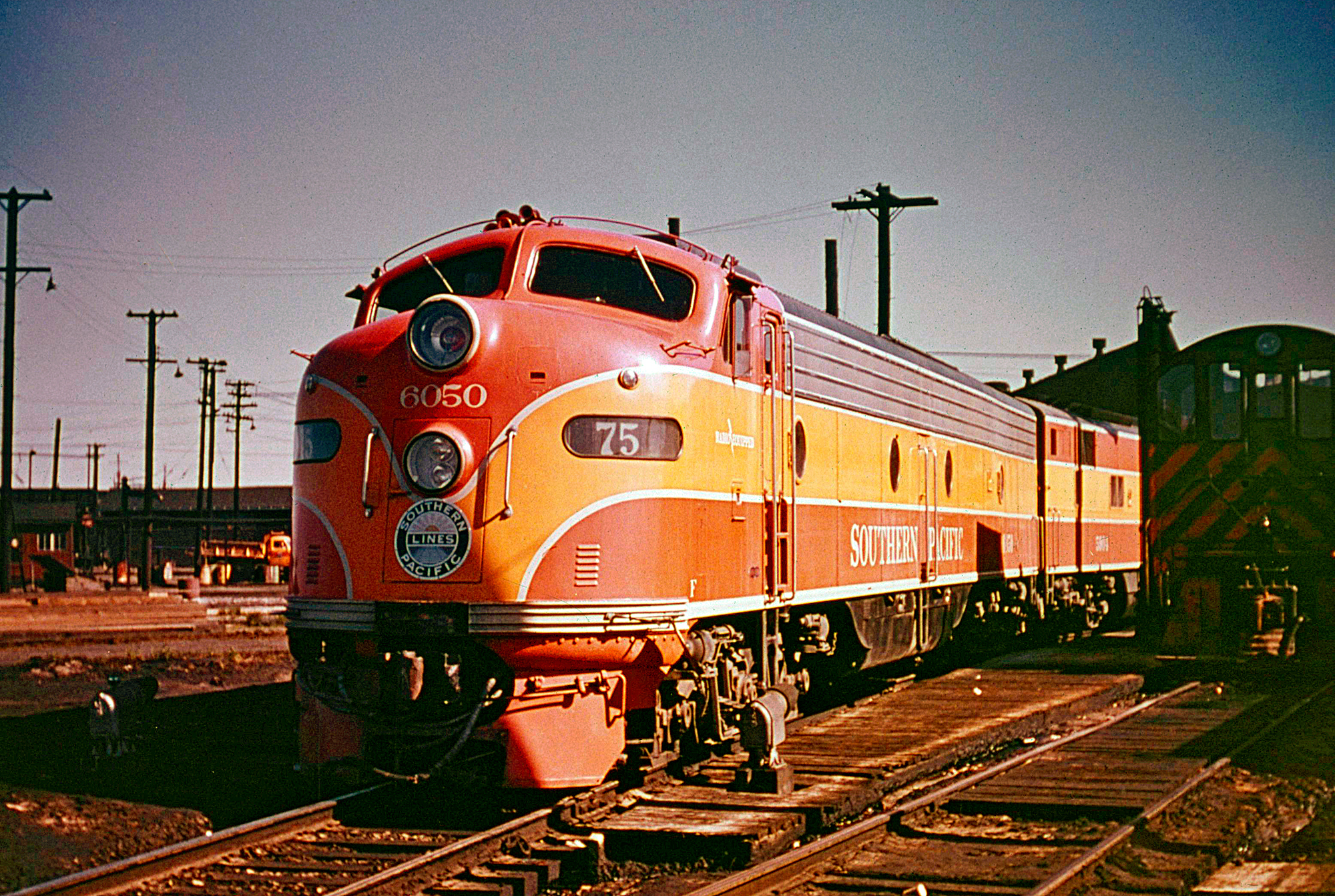 Southern Pacific E9A #6050 has arrived at the Mission Bay Roundhouse and servicing facilities in San Francisco after making a run up the coast with train #75 (Los Angeles - San Francisco) in February, 1955. American-Rails.com collection.
Southern Pacific E9A #6050 has arrived at the Mission Bay Roundhouse and servicing facilities in San Francisco after making a run up the coast with train #75 (Los Angeles - San Francisco) in February, 1955. American-Rails.com collection.Classic American Railroads
The latter 19th century witnessed many fallen flags brought together while others, such as the Western Maryland and Virginian Railway, completed their systems in the early 1900's.
The classic American railroad as we best remember it survived until the 1970's, a decade that reached a crescendo of bankruptcies and mergers.
The government's severe regulations, dating back to the early 20th century, were largely to blame along with the railroads' difficulty in reducing crew sizes (even after technological advancements, including diesel locomotives, wireless radio, and computerization made such possible).
These issues were partially self-inflicted, a result of executive greed and hubris during the 19th century that led to much of the federal oversight.
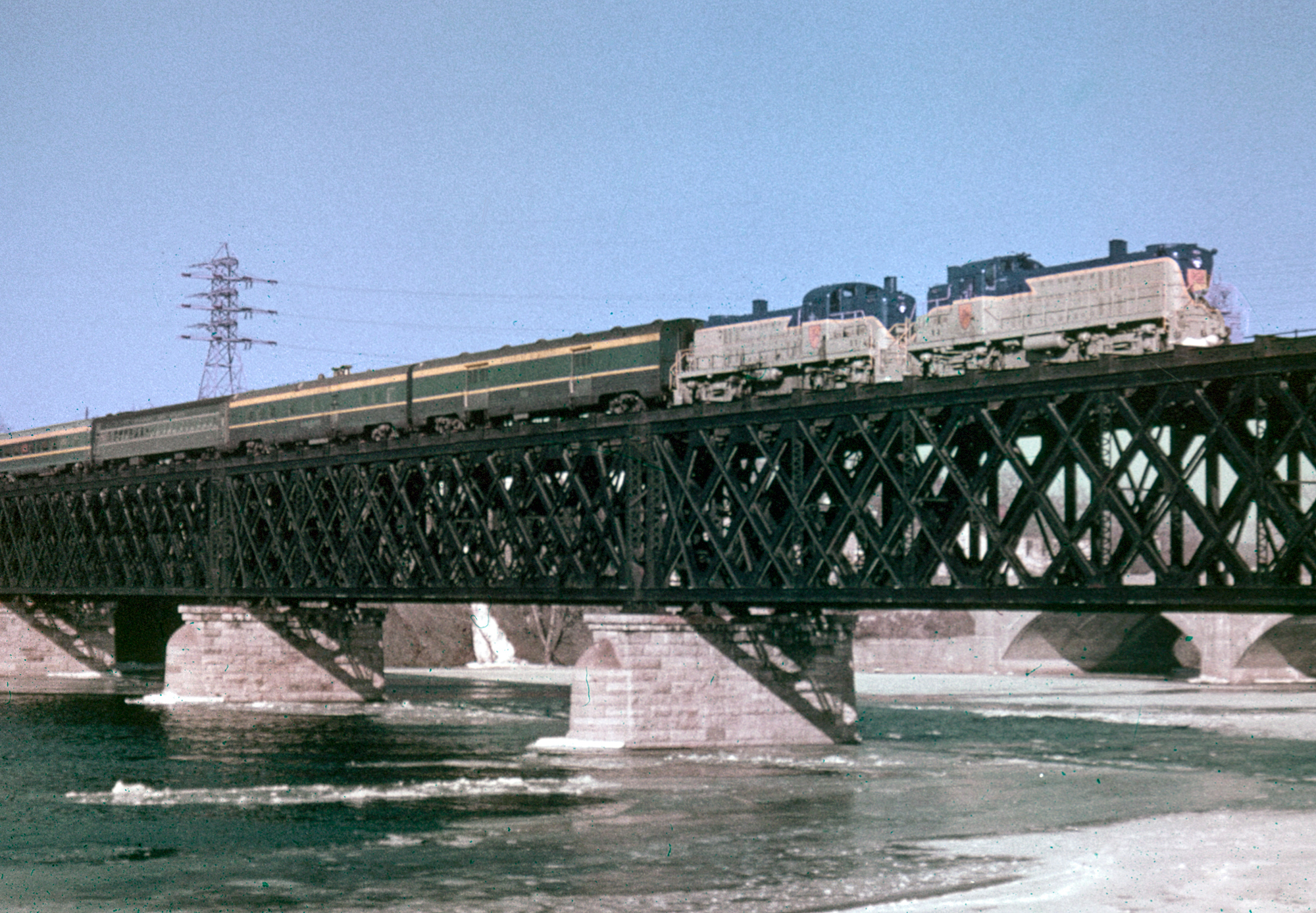 Delaware & Hudson's southbound "Laurentian" crosses the Mohawk River at Cohoes, New York during February of 1968. Jim Shaughnessy photo. Author's collection.
Delaware & Hudson's southbound "Laurentian" crosses the Mohawk River at Cohoes, New York during February of 1968. Jim Shaughnessy photo. Author's collection.While the "Golden Age" officially extended from the 1880's until the Great Depression, ask most railfans the single greatest period and many would point to immediate post-World War II era, through the 1960's.
During this time, although in decline, the industry was still generally profitable while it made the switch from steam to diesel-electric technology.
In addition, numerous, vibrant paint schemes adorned first-generation diesels, built by the five major manufacturers (Electro-Motive, American Locomotive, Fairbanks-Morse, Baldwin, and General Electric).
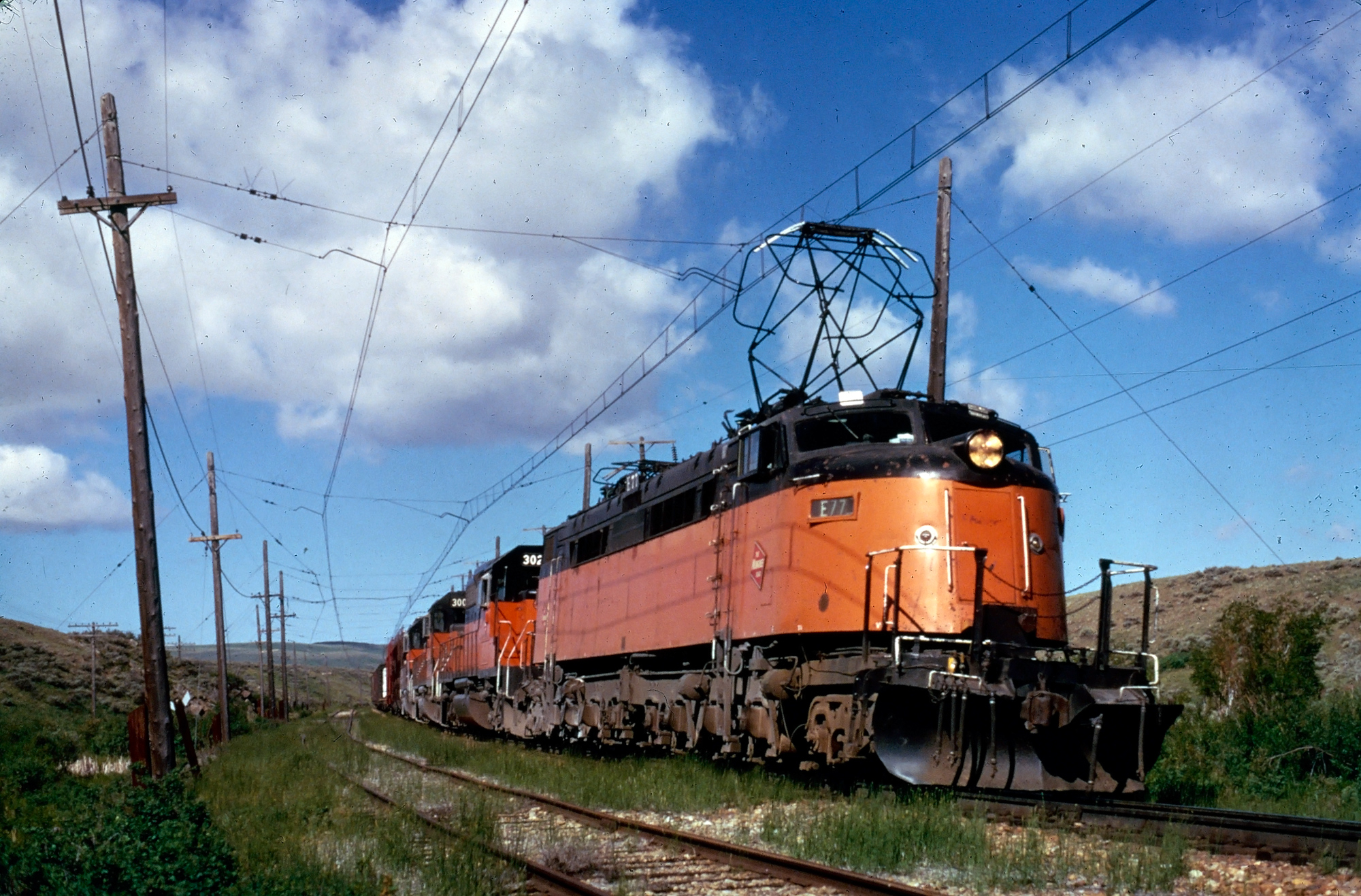 Milwaukee Road "Little Joe" E-77 and a trio of SD40-2's lead an eastbound freight at rural Bruno, Montana on July 1, 1973. American-Rails.com collection.
Milwaukee Road "Little Joe" E-77 and a trio of SD40-2's lead an eastbound freight at rural Bruno, Montana on July 1, 1973. American-Rails.com collection.With a plethora of different emblems roaming the rails it was quite an era for anyone interested in trains. Because these many systems served a particular region it was not uncommon for local communities to call a railroad their own.
Examples here include the New York Central, Reading, New Haven, Western Pacific, Atlantic Coast Line, Missouri Pacific, and the list goes on of carriers serving either a block of states or specific area.
Following the mega-merger movement this is no longer the case as a single railroad can now extend from New York to Chicago or link San Francisco with St. Louis.
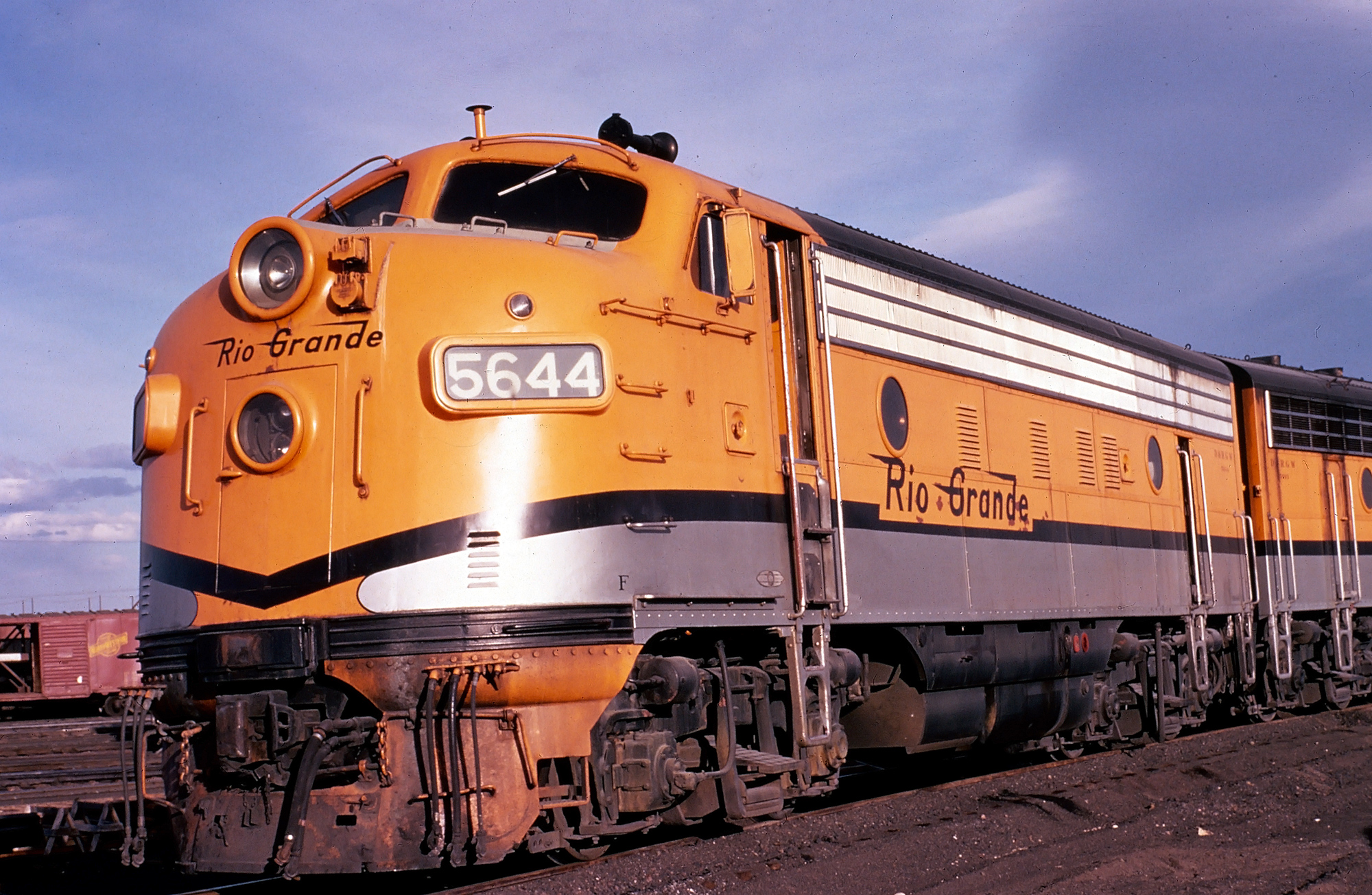 Rio Grande F7A #5644 in Denver, circa 1970. Robert Eastwood, Jr. photo. American-Rails.com collection.
Rio Grande F7A #5644 in Denver, circa 1970. Robert Eastwood, Jr. photo. American-Rails.com collection.Through the many mergers over the years not every classic system has disappeared. The two most notable include Union Pacific and Kansas City Southern; the former has been an American institution for generations.
UP recognized the need to expand and grow as the merger movement picked up adding the Western Pacific, Missouri Pacific, Chicago & North Western, Rio Grande, Missouri-Kansas-Texas, and Southern Pacific to its network from the 1980's through mid-1990's.
In addition, the much smaller Kansas City Southern managed to survive as the smallest Class I system for decades. For many years this regional pike operated a system of less than 1,000 miles connecting Kansas City with the Gulf Coast.
It then rapidly grew during the 1990's as it expanded north into St. Louis and Illinois and south into Mexico. The KCS finally disappeared in April, 2023 when it joined Canadian Pacific to form the Canadian Pacific Kansas City Railroad.
There are many other lesser known railroads which still carry on; names like the Ann Arbor, Florida East Coast, Susquehanna, Escanaba & Lake Superior, Iowa Traction, Louisiana & North Western, and others.
List
Northeast
Baltimore & Ohio Chicago Terminal
"Big Four Route" (Cleveland, Cincinnati, Chicago & St. Louis)
Buffalo, Rochester & Pittsburgh
Central Railroad Of New Jersey
Consolidated Rail Corporation (Conrail)
Delaware, Lackawanna & Western
Maryland & Pennsylvania Railroad ("Ma & Pa")
New York, New Haven & Hartford
Pennsylvania-Reading Seashore Lines
* This railroad is still operating, it is placed here because of its long and storied history.
** The REA was not an operating railroad but was an integral part of the industry during the "golden age" when these now-fallen flags were still operating.
Southeast
Atlantic & East Carolina Railway
Cincinnati, New Orleans and Texas Pacific Railway
Nashville, Chattanooga & St. Louis
Norfolk Southern Railway (Original)
Shamrock Coal Company's Oneida & Western
Richmond, Fredericksburg & Potomac
Tennessee, Alabama & Georgia Railway
West Point Route: Georgia Railroad/A&WP/WRoA
* This railroad is still operating, it is placed here because of its long and storied history.
Midwest
Chicago, Rock Island & Pacific
Chicago, South Shore & South Bend
Davenport, Rock Island & Northwestern
Duluth, South Shore & Atlantic
International – Great Northern Railroad
Minneapolis, Northfield & Southern
Minneapolis, St. Paul & Sault Ste. Marie (Soo Line)
Missouri-Kansas-Texas Railroad (Katy)
Monon Railroad (Chicago, Indianapolis & Louisville)
New York, Chicago & St. Louis (Nickel Plate Road)
Pittsburgh, Cincinnati, Chicago and St. Louis Railroad (Panhandle Route)
St. Louis Southwestern (Cotton Belt)
St. Louis-San Francisco Railway (Frisco)
Toledo, St. Louis and Western Railroad
* This railroad is still in operation but is placed here due to its historical significance.
** Despite still being in operation the original TP&W is technically one of the many fallen flags presented here since it disappeared into the Santa Fe in 1983. The company was reborn in 1988.
West/Southwest
SPSF Railway (Santa Fe-Southern Pacific)
Northwest
Milwaukee Road's Pacific Extension
Canada
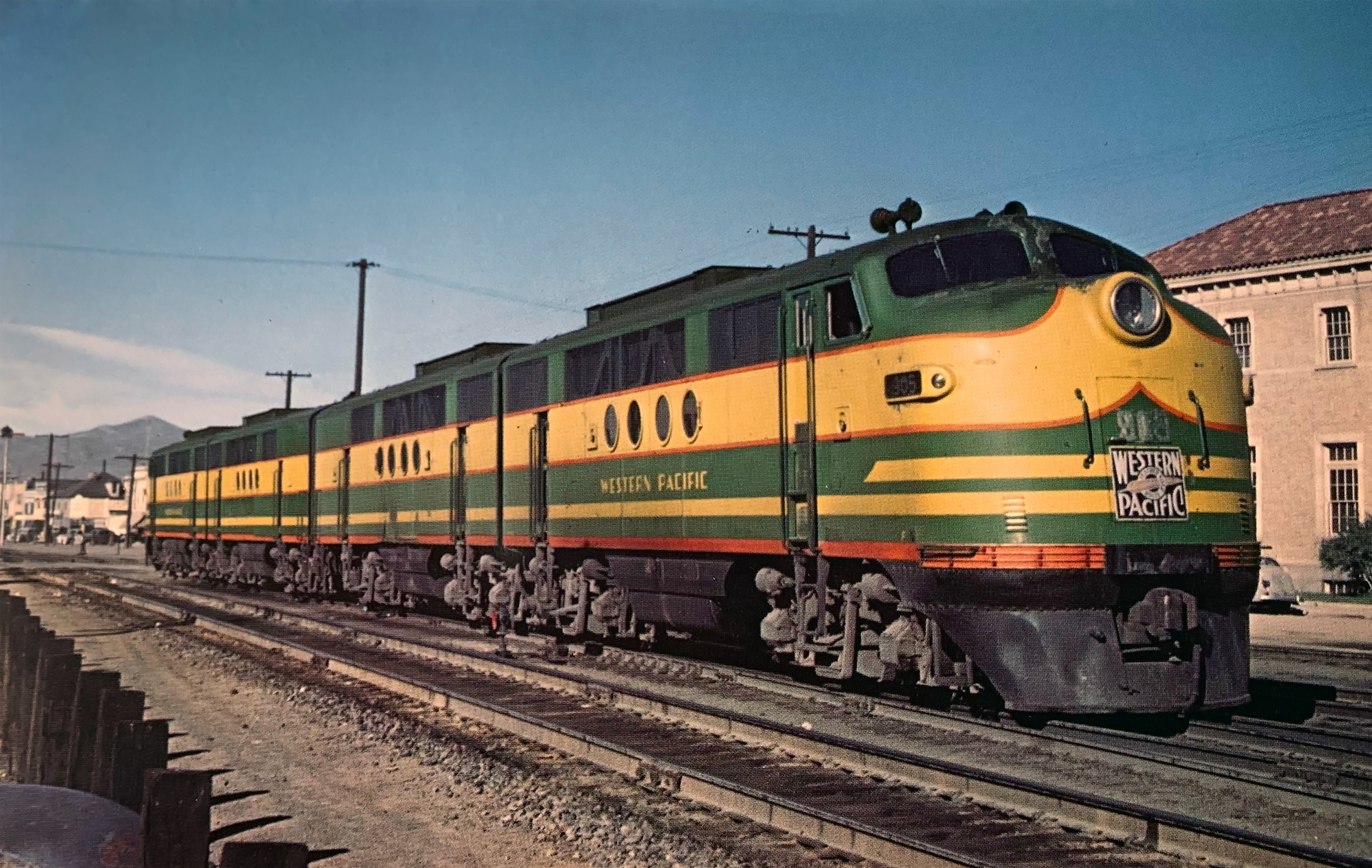 A beautiful set of Western Pacific FT's (#900/A/B/C) await their next assignments on Southern Pacific's "drill track" in downtown Elko, Nevada on June 13, 1946. According to Virgil Staff: "The famous paired trackage agreement, formalized between Western Pacific and Southern Pacific railroads on February 28, 1924 enables operation of all eastbound traffic over the Western Pacific and all westbound over the Southern Pacific. Between Wesco and bridge 633.47 where the Southern Pacific crosses underneath, the Western Pacific eastbound trackage lies to the north of the Southern Pacific. From bridge 633.47 to Alazon the Southern Pacific lies to the north and the Western Pacific to the south." Richard Kindig photo. American-Rails.com collection.
A beautiful set of Western Pacific FT's (#900/A/B/C) await their next assignments on Southern Pacific's "drill track" in downtown Elko, Nevada on June 13, 1946. According to Virgil Staff: "The famous paired trackage agreement, formalized between Western Pacific and Southern Pacific railroads on February 28, 1924 enables operation of all eastbound traffic over the Western Pacific and all westbound over the Southern Pacific. Between Wesco and bridge 633.47 where the Southern Pacific crosses underneath, the Western Pacific eastbound trackage lies to the north of the Southern Pacific. From bridge 633.47 to Alazon the Southern Pacific lies to the north and the Western Pacific to the south." Richard Kindig photo. American-Rails.com collection.Here within this page you will find information on some of the best remembered fallen flags, each described in much more detail, broken down into the territory where they operated.
Since the website debuted I have finally had the chance to feature many of these although I realize that some are still omitted. As time allows, I will try to cover most of these companies. As it currently stands there are already more than 100 such systems highlighted.
You may notice that Canadian National and Canadian Pacific are now included in the website. After giving it much thought the two lines have played too significant a role in our nation's railroad history, especially in its current and future state, to be left out and unmentioned.
For instance several are now of Canadian ownership/control such as the Soo Line (and indirectly the Milwaukee Road through the Soo's takeover by CP), Delaware & Hudson (today, partially owned by Norfolk Southern), Illinois Central, Grand Trunk Western, Central Vermont, and the Duluth, Winnipeg & Pacific Railway.
Recent Articles
-
Kentucky Dinner Train Rides In Bardstown!
Jan 13, 26 01:14 PM
The essence of My Old Kentucky Dinner Train is part restaurant, part scenic excursion, and part living piece of Kentucky rail history. -
Kansas Dinner Train Rides In Abilene!
Jan 13, 26 12:44 PM
If you’re looking for a heritage railroad that feels authentically Kansas—equal parts prairie scenery, small-town history, and hands-on railroading—the Abilene & Smoky Valley Railroad (A&SV) delivers. -
Michigan ~ Murder Mystery ~ Dinner Train Rides
Jan 13, 26 11:24 AM
Among the lesser-known treasures of this state are the intriguing murder mystery dinner train rides—a perfect blend of suspense, dining, and scenic exploration. -
Virginia's - Murder Mystery - Dinner Train Rides
Jan 13, 26 11:11 AM
Among the state's railroad attractions, murder mystery dinner trains stand out as a captivating fusion of theatrical entertainment, fine dining, and scenic travel. -
Arizona Dinner Train Rides At The Grand Canyon!
Jan 13, 26 10:59 AM
While the Grand Canyon Railway does not offer a true, onboard dinner train experience it does offer several upscale options and off-train dining. -
Georgia Dinner Train Rides In Nashville!
Jan 13, 26 10:27 AM
If you’ve ever wished you could slow down, trade traffic for jointed rail, and let a small-town landscape roll by your window while a hot meal is served at your table, the Azalea Sprinter delivers tha… -
Indiana Valentine's Train Rides
Jan 12, 26 04:27 PM
If you’ve ever wished you could step into a time when passenger trains were a Saturday-night treat and a whistle echoing across farm fields meant “adventure,” the Nickel Plate Express delivers that fe… -
Ohio Valentine's Train Rides!
Jan 12, 26 04:20 PM
The Hocking Valley Scenic Railway offers one of the region’s most atmospheric ways to experience the Hocking Hills area: from the rhythmic click of jointed rail to the glow of vintage coaches rolling… -
Wisconsin's - Wine Tasting - Train Rides
Jan 12, 26 03:10 PM
Wisconsin might not be the first state that comes to mind when one thinks of wine, but this scenic region is increasingly gaining recognition for its unique offerings in viticulture. -
California's - Wine Tasting - Train Rides
Jan 12, 26 02:34 PM
This article explores the charm, routes, and offerings of these unique wine tasting trains that traverse California’s picturesque landscapes. -
Wisconsin Scenic Train Rides In North Freedom!
Jan 12, 26 02:20 PM
The Mid-Continent Railway Museum is a living-history museum built around the sights, sounds, and everyday rhythms of small-town and shortline railroading in the early 20th century, what the museum cal… -
Vermont Scenic Train Rides In Burlington!
Jan 12, 26 01:18 PM
Today, GMRC is best known by many travelers for its Burlington-based passenger experiences—most famously the Champlain Valley Dinner Train and the sleek, limited-capacity Cocktails on the Rails. -
Maryland's - Murder Mystery - Dinner Train Rides
Jan 12, 26 01:03 PM
Maryland is known for its scenic landscapes, historical landmarks, and vibrant culture, but did you know that it’s also home to some of the most thrilling murder mystery dinner trains? -
Minnesota's - Murder Mystery - Dinner Train Rides
Jan 12, 26 12:17 PM
Murder mystery dinner trains offer an enticing blend of suspense, culinary delight, and perpetual motion, where passengers become both detectives and dining companions on an unforgettable journey. -
Vermont Dinner Train Rides In Burlington!
Jan 12, 26 12:09 PM
There is one location in Vermont hosting a dedicated dinner train experience at the Green Mountain Railroad. -
Connecticut Dinner Train Rides In Essex!
Jan 12, 26 10:39 AM
Connecticut's rail heritage can be traced back to the industry's earliest days and a few organizations preserve this rich history by offering train rides. The Essex Steam Train also hosts dinner-theme… -
Florida Scenic Train Rides In Parrish!
Jan 11, 26 10:26 PM
The Florida Railroad Museum (FRRM) in Parrish offers something increasingly rare in today’s rail landscape: a chance to ride historic equipment over a surviving fragment of an early-20th-century mainl… -
California's - Wine Tasting - Train Rides
Jan 11, 26 02:28 PM
This article explores the charm, routes, and offerings of these unique wine tasting trains that traverse California’s picturesque landscapes. -
Georgia's - Murder Mystery - Dinner Train Rides
Jan 11, 26 02:07 PM
In the heart of the Peach State, a unique form of entertainment combines the thrill of a murder mystery with the charm of a historic train ride. -
Colorado ~ Murder Mystery ~ Dinner Train Rides
Jan 11, 26 01:43 PM
Nestled among the breathtaking vistas and rugged terrains of Colorado lies a unique fusion of theater, gastronomy, and travel—a murder mystery dinner train ride. -
Minnesota Dinner Train Rides In Duluth!
Jan 11, 26 01:32 PM
One of the best ways to feel the region's history in motion today is aboard the North Shore Scenic Railroad (NSSR), which operates out of Duluth’s historic depot. -
Illinois Dinner Train Rides At Monticello!
Jan 11, 26 12:42 PM
The Monticello Railway Museum (MRM) is one of those places that quietly does a lot: it preserves a sizable collection, maintains its own operating railroad, and—most importantly for visitors—puts hist… -
Alabama's - Wine Tasting - Train Rides
Jan 10, 26 09:29 AM
While the state might not be the first to come to mind when one thinks of wine or train travel, the unique concept of wine tasting trains adds a refreshing twist to the Alabama tourism scene. -
Maryland Dinner Train Rides At WMSR!
Jan 10, 26 09:13 AM
The Western Maryland Scenic Railroad (WMSR) has become one of the Mid-Atlantic’s signature heritage operations—equal parts mountain railroad, living museum, and “special-occasion” night out. -
Arkansas Dinner Train Rides On The A&M!
Jan 10, 26 09:11 AM
If you want a railroad experience that feels equal parts “working short line” and “time machine,” the Arkansas & Missouri Railroad (A&M) delivers in a way few modern operations can. -
South Dakota's - Murder Mystery - Dinner Train Rides
Jan 10, 26 09:08 AM
While the state currently does not offer any murder mystery dinner train rides, the popular "1880 Train" at the Black Hills Central recently hosted these popular trips! -
Wisconsin's - Murder Mystery - Dinner Train Rides
Jan 10, 26 09:07 AM
Whether you're a fan of mystery novels or simply relish a night of theatrical entertainment, Wisconsin's murder mystery dinner trains promise an unforgettable adventure. -
Missouri's - Murder Mystery - Dinner Train Rides
Jan 10, 26 09:05 AM
Missouri, with its rich history and scenic landscapes, is home to one location hosting these unique excursion experiences. -
Washington ~ Murder Mystery ~ Dinner Train Rides
Jan 10, 26 09:04 AM
This article delves into what makes murder mystery dinner train rides in Washington State such a captivating experience. -
Kentucky Scenic Train Rides At KRM!
Jan 09, 26 11:13 PM
Located in the small town of New Haven the Kentucky Railway Museum offers a combination of historic equipment and popular excursions. -
Washington "Wine Tasting" Train Rides
Jan 09, 26 08:53 PM
Here’s a detailed look at where and how to ride, what to expect, and practical tips to make the most of wine tasting by rail in Washington. -
Kentucky's - Wine Tasting - Train Rides
Jan 09, 26 08:21 PM
Kentucky, often celebrated for its rolling pastures, thoroughbred horses, and bourbon legacy, has been cultivating another gem in its storied landscapes; enjoying wine by rail. -
Kentucky's - Murder Mystery - Dinner Train Rides
Jan 09, 26 01:12 PM
In the realm of unique travel experiences, Kentucky offers an enchanting twist that entices both locals and tourists alike: murder mystery dinner train rides. -
Utah's - Murder Mystery - Dinner Train Rides
Jan 09, 26 01:05 PM
This article highlights the murder mystery dinner trains currently avaliable in the state of Utah! -
North Carolina Dinner Train Rides At NCTM!
Jan 09, 26 12:51 PM
Tucked into the Piedmont town of Spencer, the North Carolina Transportation Museum is the kind of place that feels less like a typical museum and more like a living rail yard that never quite stopped… -
Tennessee Dinner Train Rides At The TVRM!
Jan 09, 26 12:39 PM
Tucked into East Chattanooga, the Tennessee Valley Railroad Museum (TVRM) is less a “museum you walk through” and more a railroad you step aboard. -
New York Scenic Train Rides On The A&A!
Jan 09, 26 11:20 AM
The A&A is both a common-carrier short line moving freight and a heritage railroad hosting popular excursion trains, all on the same storied right-of-way. -
Pennsylvania Scenic Train Rides In Hollidaysburg!
Jan 09, 26 11:14 AM
Tucked into the Juniata River valley just south of Altoona, the Everett Railroad offers one of the most approachable—and photogenic—heritage-rail experiences in Pennsylvania -
Montana Dinner Train Rides Near Lewistown!
Jan 08, 26 03:03 PM
The Charlie Russell Chew Choo turns an ordinary rail trip into an evening event: scenery, storytelling, live entertainment, and a hearty dinner served as the train rumbles across trestles and into a t… -
Alabama's - Murder Mystery - Dinner Train Rides
Jan 08, 26 02:19 PM
There is currently one location in the state offering a murder mystery dinner experience, the Wales West Light Railway! -
Rhode Island's - Murder Mystery - Dinner Train Rides
Jan 08, 26 01:43 PM
Let's dive into the enigmatic world of murder mystery dinner train rides in Rhode Island, where each journey promises excitement, laughter, and a challenge for your inner detective. -
Florida's - Wine Tasting - Train Rides
Jan 08, 26 01:13 PM
Wine by train not only showcases the beauty of Florida's lesser-known regions but also celebrate the growing importance of local wineries and vineyards. -
Texas's - Wine Tasting - Train Rides
Jan 08, 26 12:30 PM
This article invites you on a metaphorical journey through some of these unique wine tasting train experiences in Texas. -
New York's - Wine Tasting - Train Rides
Jan 08, 26 11:32 AM
This article will delve into the history, offerings, and appeal of wine tasting trains in New York, guiding you through a unique experience that combines the romance of the rails with the sophisticati… -
California Dinner Train Rides In Sacramento!
Jan 08, 26 11:21 AM
Just minutes from downtown Sacramento, the River Fox Train has carved out a niche that’s equal parts scenic railroad, social outing, and “pick-your-own-adventure” evening on the rails. -
New Jersey Dinner Train Rides In Woodstown!
Jan 08, 26 10:31 AM
For visitors who love experiences (not just attractions), Woodstown Central’s dinner-and-dining style trains have become a signature offering—especially for couples’ nights out, small friend groups, a… -
Nevada's - Murder Mystery - Dinner Train Rides
Jan 07, 26 02:12 PM
Seamlessly blending the romance of train travel with the allure of a theatrical whodunit, these excursions promise suspense, delight, and an unforgettable journey through Nevada’s heart. -
West Virginia's - Murder Mystery - Dinner Train Rides
Jan 07, 26 02:08 PM
For those looking to combine the allure of a train ride with an engaging whodunit, the murder mystery dinner trains offer a uniquely thrilling experience. -
Kansas's - Murder Mystery - Dinner Train Rides
Jan 07, 26 01:53 PM
Kansas, known for its sprawling wheat fields and rich history, hides a unique gem that promises both intrigue and culinary delight—murder mystery dinner trains. -
Michigan's - Wine Tasting - Train Rides
Jan 07, 26 12:36 PM
In this article, we’ll delve into the world of Michigan’s wine tasting train experiences that cater to both wine connoisseurs and railway aficionados.














































